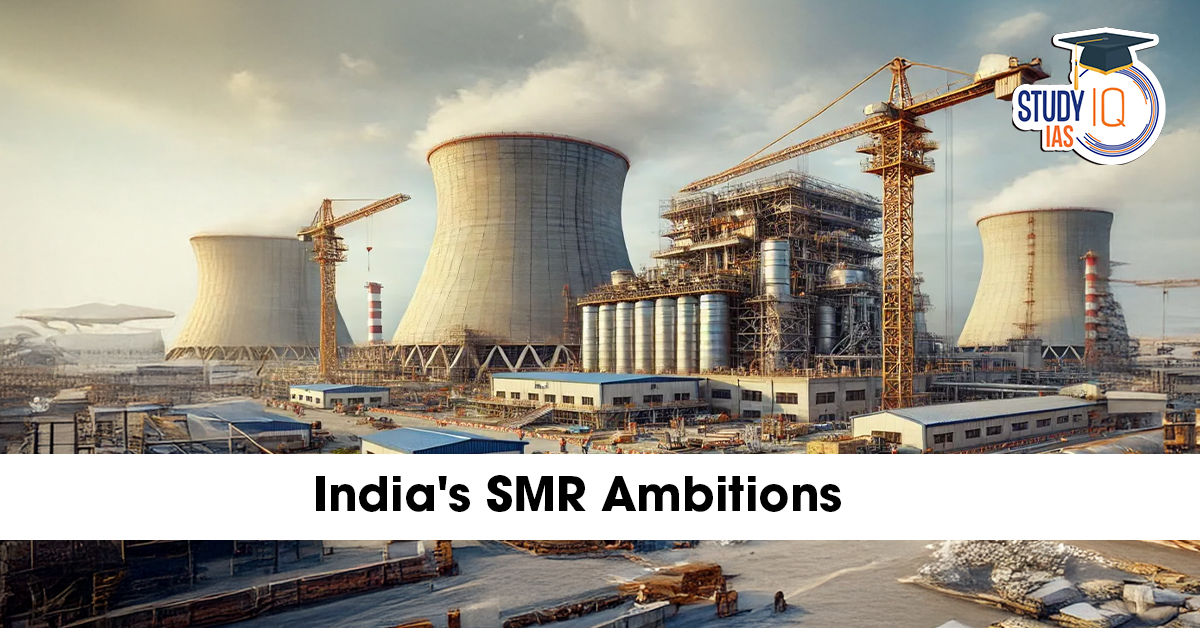Table of Contents
India’s nuclear energy sector is on the brink of transformation. With growing energy demand, climate commitments, and industrial expansion, the country is turning toward Small Modular Reactors (SMRs) as a sustainable and scalable solution.
SMRs promise low-carbon, reliable power for industries while complementing renewables like solar and wind. As global energy systems move toward decentralized clean grids, SMRs can help India achieve its Net-Zero 2070 target and industrial self-reliance under Atmanirbhar Bharat.
What Are Small Modular Reactors (SMRs)?
Small Modular Reactors (SMRs) are compact nuclear reactors that typically produce 30–300 MWe of electricity per unit. Unlike conventional large nuclear plants, SMRs are:
-
Modular and factory-built, reducing construction time and cost.
-
Scalable, allowing phased capacity expansion.
-
Inherently safe, with passive cooling and automatic shutdown systems.
-
Flexible in deployment, suitable for remote areas or industrial clusters.
Globally, SMRs are gaining traction as a key clean energy technology for the 21st century nuclear renaissance.
India’s Nuclear Reforms: Opening Doors for Private Players
For the first time, India has opened its nuclear energy sector to private firms under strict regulatory oversight. The Nuclear Power Corporation of India Ltd (NPCIL) will retain operational control, while private industries finance and use the generated power.
Private Players in SMR Development:
-
Reliance Industries
-
Tata Power
-
Adani Power
-
Hindalco Industries
-
JSW Energy
-
Jindal Steel & Power
These companies are investing in SMR projects across Gujarat, Madhya Pradesh, Odisha, Andhra Pradesh, Jharkhand, and Chhattisgarh — a move that merges industrial innovation with clean nuclear power.
Bharat Small Modular Reactor (BSMR) Initiative
The Bharat Small Modular Reactors (BSMR) initiative represents India’s ambitious roadmap to build and deploy indigenous SMRs by 2033.
Under this initiative, NPCIL and Bhabha Atomic Research Centre (BARC) will collaborate with the private sector to develop and operate modular reactors for industrial decarbonisation and grid stability.
Key features include:
-
Public–Private Partnership (PPP) model for financing and operation.
-
NPCIL oversight for safety and regulatory compliance.
-
Private sector access to generated power for captive industrial use.
This marks the first time India has invited private participation in nuclear power generation—a landmark policy reform aimed at energy security and economic growth.
Technology Mix: India’s Innovative Approach
To ensure technological self-reliance and compatibility with global standards, India is developing three SMR prototypes under BARC:
-
BSMR (200 MWe) – Based on Pressurised Water Reactor (PWR) design, aligning with global benchmarks.
-
BSR (220 MWe) – Continues India’s legacy Pressurised Heavy Water Reactor (PHWR) technology.
-
SMR-55 (55 MWe) – Compact and flexible light-water reactor suited for smaller installations or remote regions.
This diverse mix allows India to build on its domestic strengths while entering the global SMR supply chain.
Industrial and Clean Energy Impact
India’s SMR strategy is designed to decarbonize high-emission industries and stabilize renewable-heavy power grids.
Key Benefits:
-
Provides 24×7 clean power for steel, cement, aluminium, and fertilizer industries.
-
Enables reuse of old thermal plant sites, minimizing land and water requirements.
-
Supports AI-driven data centers and digital infrastructure with reliable electricity.
-
Reduces import dependency on coal and natural gas.
SMRs thus bridge the gap between industrial energy security and climate sustainability.
Union Budget 2025–26: Boost for SMR Development
The Union Budget 2025–26 introduced a dedicated Nuclear Energy Mission with a strong focus on SMRs.
Budget Highlights:
-
₹20,000 crore allocated for SMR R&D and pilot projects.
-
Goal: Commission at least five indigenous SMRs by 2033.
-
Establishment of India’s first SMR Innovation Hub under the Department of Atomic Energy.
-
Incentives for private investment and technology transfer partnerships.
This financial commitment solidifies India’s position as a front-runner in next-generation nuclear innovation.
Global Context and Competitive Edge
Globally, countries like the US, UK, Russia, and China are advancing SMR deployment:
-
Russia’s Akademik Lomonosov (70 MWe, floating plant) – operational since 2020.
-
China’s HTR-PM – world’s first commercial high-temperature gas-cooled SMR (2023).
-
The US and UK are fast-tracking designs from NuScale, Rolls-Royce SMR, and GE-Hitachi.
By joining this global race, India not only diversifies its energy mix but also builds export potential for indigenous SMR technology under the “Make in India” framework.
Challenges and the Road Ahead
Despite optimism, India faces key challenges:
-
Regulatory clarity on private participation and safety standards.
-
Public trust in nuclear energy post-Fukushima concerns.
-
High upfront costs and financing risks for pilot SMRs.
-
Need for international cooperation on uranium supply and technology sharing.
Addressing these challenges through transparent policies, safety education, and R&D support will be critical for success.
Conclusion
India’s SMR journey represents a new chapter in energy innovation — one that blends clean power, industrial growth, and strategic self-reliance.
With public-private collaboration, strong government backing, and indigenous technology, India is poised to become a global leader in small modular reactor development by the next decade.
The era of compact, efficient, and sustainable nuclear energy has begun — and India is at its forefront.


 UN ESCAP Asia-Pacific Disaster Report 20...
UN ESCAP Asia-Pacific Disaster Report 20...
 Rare Hawfinch Sighting in Corbett Nation...
Rare Hawfinch Sighting in Corbett Nation...
 Bnei Menashe Community : The Lost Tribe ...
Bnei Menashe Community : The Lost Tribe ...

























